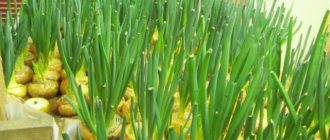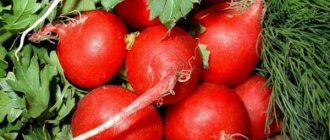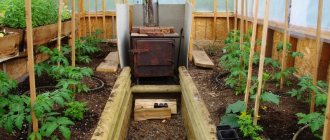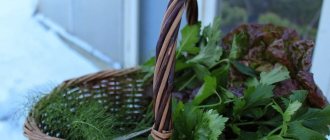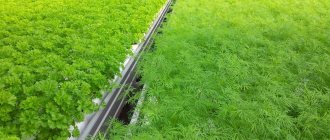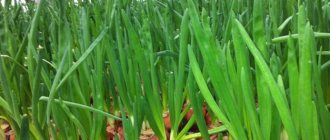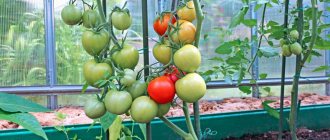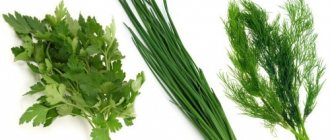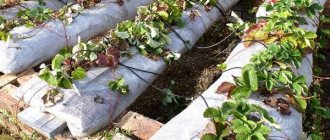Technologies for growing greens (as well as radishes, cucumbers, peppers and much more) in a greenhouse excite the minds of many happy owners of these very useful structures, which allow them to obtain additional harvests in the cold season. This is explained by the fact that herbs are in demand all year round, but at the same time they are characterized by simplicity of agricultural technology and active growth of green mass. There are different technologies for growing greens in a greenhouse, which allow you not only to constantly supply your table with fresh herbs or green onions, but also to earn good money from it.
Growing greens. Selection of planting material, seeds
Parsley . Biennial plant. It has two types: root (cone-shaped, thickened root) and leaf (thin, curved root). Each species has its own varieties. It has increased frost resistance (tolerates down to -10°C). The harvest can be harvested from early spring to late autumn. The necessary conditions for this are very simple. It is recommended to plant at certain intervals, for example every three weeks. To do this, in the prepared beds we make grooves 1-2 cm deep at a distance of 15 cm from each other. The first shoots should appear in 9 to 15 days. Parsley is not covered for the winter. The basics of care are quite simple: water the greenery in the evening , thin out when 1-2 leaves of the plant appear (the first time you need to leave a distance of 3 cm, after a couple of weeks we increase the distance to 10 cm), remove weeds and loosen the soil. As for fertilizing, if you have fertilized the soil, you do not need to take any additional actions. And if something bothers you, then during the growing season you can feed parsley with nitrogen fertilizers.
In fact, there are not many varieties of parsley. You can easily choose seeds for growing greens according to your taste and desire. The most popular: Sugar, Leaf, Ordinary, Curly.
Dill . An annual herbaceous plant. The necessary conditions for growing this herb are similar to those for parsley. Seeds can germinate already at a temperature of -4°C. That is, already in April you can start planting seeds in open ground. If frosts are expected, the seedlings must be covered with protective material. The greens of plants planted in the fall can be cut two weeks earlier. Dill loves sunlight and constant watering, i.e. wet soil. To prevent this plant from turning into an ordinary weed, allocate a separate bed for it. Also, care features include thinning seedlings that have reached approximately 6 cm in height. The final distance from each other should be approximately 20 cm.
Dill varieties differ little from each other in taste and aroma. The main difference in terms of ripening:
• early ripening (Gribovsky, Dalniy, Aurora);
• mid-season Lesnogorodsky, Bushy, Abundant-leaved);
• late ripening (Alligator, Kibray, Dill).
Green onions . Biennial and perennial herbaceous plant of the bulbous family. It is unpretentious to climatic conditions and is easy to maintain. Different varieties of greens are grown in approximately the same way with the same necessary conditions. For planting, take a medium or small sized bulb. A large onion will take up a lot of space and will take longer to remove the feather. Onions can be planted in open ground in the fall before frost, or in early spring. You need to choose a place that is sunny and dry. Watering must be done regularly, preventing the soil from drying out. Before planting, it is recommended to soak the bulbs in warm water for 24 hours and cut off the tops. It is believed that thanks to these simple actions, onions will be forced into greens faster and the yield will increase. Most often, onions are planted so-called. using the strip method, in which the bulbs are laid at a distance of 2-5 cm from each other between rows located approximately 10-20 cm apart.
Onion diagram for planting
But the bridge method can also be used, in which the bulbs are laid close to each other (10 kg of onions per 1 m²). If planting takes place in winter, it is recommended to sprinkle a small layer of humus or manure on top, and in the spring remove and install a film frame on the bed. From October to April it is recommended to grow onions for greens in a greenhouse, and from February to May - in a greenhouse. Conventional mineral, organic or mixed fertilizers are recommended as top dressing. No chemicals should be used when forcing onions onto greens. The feather is collected when it reaches a height of 24-42 cm.
The most famous types of onions are: spring onions, chives, slime, shallots.
There are also general tips and rules that apply to all types and varieties of greens:
1) It is better to prepare beds for planting greenery in the fall. Apply organic (for example, manure) and mineral fertilizers at the same time. In the spring, complex fertilizers containing potassium, phosphorus, nitrogen, superphosphate are additionally applied; carbamide (urea) or ammonium nitrate can be added. It is recommended to sow in moist soil in furrows 2 cm deep, do not sprinkle too much soil.
2) It is believed that autumn planting of dill produces a much better harvest than spring planting. The plant will be more resilient and less susceptible to disease.
3) There is one general rule for seeds: before sowing, place them in a 1% manganese solution and leave for 12 hours. This is necessary for disinfection and replenishment with the necessary microelements for growth. The germination rate will be much higher than that of dry seeds.
4) When choosing seeds, pay attention to the expiration date and manufacturer.
Dill
Early harvest of dill
A fragrant seasoning, not a single dish can do without it. Dill is cold-resistant, not afraid of frost and grows quickly. To speed up germination, it is recommended to soak it twice in hot water until it cools. It is better to sow thicker in wide rows, and when the foliage grows by 10 cm, pull out whole bunches, thinning out in this way.
Varieties suitable for early planting in a greenhouse: Carousel, Dukat, Kibray, Almaz, Iney
Growing greens in a greenhouse
If you want to grow greens all year round, then you cannot do without a greenhouse. The necessary conditions that must be met are:
1) Earth . Typical soil composition for greenhouses includes: different types of peat, ordinary garden soil, composts of various compositions, wood waste in the form of bark, sawdust, fallen leaves, river sand and clay, manure (except pig manure), bird droppings, straw. The thickness of the soil cover is 25-30 cm. Planting can be carried out at any time using the usual methods intended for this crop.
2) Lighting . Additional lighting will prolong the feeling of daylight and give the plants additional energy.
3) Watering . It is ideal to install a drip irrigation system in a greenhouse.
4) Warmth . The optimal temperature in the greenhouse should be +18ºС.
To grow parsley in a greenhouse, use sprouted seeds. To do this, the planting material is kept for several days on gauze folded in half at room temperature until the first shoots appear. Plant the prepared seeds in the soil at intervals of 5 cm and then water well. Thin out the resulting shoots. After the first harvest, you can fertilize the soil with mullein solution. Further care will consist of maintaining optimal temperature (+12ºС -+18ºС), humidity (75%), lighting and weed removal. Harvesting can be done 30–40 days after planting.
Diagram of a greenhouse for growing parsley
To plant dill in a greenhouse, you should choose bush-type varieties. You must first soak them in water for 2 days. Dill is not picky about the soil, but it is better to fertilize it with humus and fertilize it once every two months. It is also necessary to take into account that the thickness of the soil layer should be 50 cm, since the roots of the plant are long. Needs constant watering and an additional light source. Special care requirements include thinning out plant seedlings. You can harvest dill in 20-30 days.
Planting green onions in a heated greenhouse can be done at any time of the year. To do this, you need to cut off the tops of the bulbs (don’t worry if the cut is too wide, as they grow, the resulting feathers will smooth out this cut). The soil should be well fertilized with organic compounds. A good harvest is obtained when onions are planted in boxes filled with peat, humus or compost. When caring for growing greens, the following conditions must be observed: regularly water and feed, ensure the temperature does not exceed +19°C. Additional lighting is also necessary, and the lamps should be positioned vertically, which will prevent the pen from breaking. The harvest can be harvested after 30 days.
Leaf salad
Leaf lettuce
A fast-growing vegetable, the first harvest can be harvested in 25 days. It is quite cold-resistant, almost as good as radish, but unlike the latter it is very light-loving. It is better to plant it on the south side of the greenhouse. We leave a distance of about 10 cm between the plants, and arrange them in the rows in a checkerboard pattern, then there will be enough light for it.
Varieties suitable for early planting in a greenhouse: Winter, Sorvanets, Moscow greenhouse, Emerald lace, Parliament
Home growing greens
The simplest and cheapest green vegetable garden is a vegetable garden at home. In terms of harvest volume and assortment, it is, of course, difficult to compare with ordinary ones, but having live, juicy greens at any time is quite comfortable. We are used to the fact that we can grow green onions on the windowsill, but few people know that other greens can also be grown excellently - parsley, dill, etc. Greens grown on a windowsill are in no way inferior in quality to those growing in a garden bed.
This issue also has its own secrets and necessary conditions:
1) Correct choice of seeds: these must be early ripening varieties resistant to unfavorable conditions;
2) Pre-sowing preparation of seeds and soil. Believe me, selecting and soaking seeds is not a waste of time, but a condition for the success of your garden.
When it comes to soil, you have two options:
– buy a ready-made mixture in a store (which is more convenient and easier);
- cook it yourself. Ingredients: humus, garden turf soil and complex mineral fertilizers (1 tbsp per bucket of mixture). The bottom layer of the pot or boxes should be covered with expanded clay or small pebbles. To obtain green feathers, plant the bulbs in a container that is one-third filled with soil. Also, some people lower them into a tray, adding water from time to time so that it covers the roots.
Tip: if you are reusing soil for planting, remove some of the top layer and add fresh soil with vermicompost.
3) Correct technology and care . There are several factors here:
• Drainage. Don't forget to place expanded clay or small pebbles at the bottom of your pots or boxes. This will allow the water to not stagnate and prevent the death of roots and the formation of mold.
• Do not bury seeds in the soil; sowing depth should be no more than 2 cm.
Temperature conditions. Place a thermometer on the windowsill (or other place where your garden is located) and monitor the required temperature. in the room should be - 18-28°C .
• Avoid too much sun and drafts.
• Feeding and fertilizers. No matter how hard we try, we cannot provide our plants with climatic conditions the same as in nature. various kinds of additives will come to our rescue . Organic fertilizers such as manure will have to be abandoned. They are not suitable for a balcony or window sill.
4) Lighting. It is better to place plants on a windowsill located in the southeast. If this is not possible, then additional lighting will come to the rescue. Its deficiency can be detrimental to growing greens.
5) Watering should be done as the plant dries out. In summer this will be done more often and more abundantly, in winter less often. Use water at room temperature so as not to kill the plants.
Greenery on the windowsill
Harvesting
When dill and parsley ripen, it is necessary to properly harvest and store the crop. Greens are a perishable product, but thanks to simple tricks you can extend the life and preserve the presentation of the product. Before harvesting, you should water the garden bed with water. Thus, it will be more convenient to dig up the plant and clear its roots from the soil. After this, the dill should be placed in a waterproof container; to preserve its presentation, you can pour water into the container with the addition of aspirin and fertilizer. At temperatures up to +10 degrees, the greens will remain fresh for a week. Video on the topic
Growing greens for sale
This idea is considered promising and profitable. It does not require large financial investments, the demand for greens is stable, the yield is high, the growing period is short, and the return on investment is attractive. But there is still a fly in the ointment here too. This is a sales market. This is your main task. There is no point in selling to resellers for pennies. We need to look for serious clients. You can offer your services to cafes, restaurants, shops, but here you will be required to provide documents. Opening an individual business also involves certain hassles and costs. Another option is to stand on the market yourself. In any case, you must take into account all costs. If you sell surplus, then do not count on special cash income. You can only make money on large volumes of production. And if you plan to grow greens for sale, then be sure to take into account the cost of heating and lighting the greenhouse, which you cannot do without. Now this is a very large cost item. It is also necessary to take into account the costs of renting land (if implemented), building a greenhouse, transportation costs, and hired labor (if used). If the above points do not scare you, and you are ready to establish contacts on the product sales market, then the “green” business will pay off your hopes.
For example, consider the leader of this business - green onions. The yield per cutting can be 1.5 kg per m². The ripening period is 30 days. The average annual retail price of a kilogram of greens is approximately 300 rubles per kg. The price for purchasing bulbs for sowing will be approximately 10-20 rubles per kg. At the same time, we do not yet take into account that boxes with bulbs can be placed on racks, on top of each other, and there are also varieties of onions that give higher yields. Based on the above figures, everyone can calculate for themselves the cost and estimated profitability of this type of business. Already established businessmen talk about 100% profit, and in some cases even more.
The necessary conditions for growing greens for a business are practically no different from the basic ones. Planting can be done all year round using a conveyor belt method to obtain a continuous harvest. Watering must be timely so that the soil does not dry out. And with this you will be greatly assisted by a drip irrigation system that you can make yourself. It is also necessary to fertilize plants more carefully, since the plant may become sick, may be infected with pests, and the soil will become depleted over time. All this requires the use of special complex fertilizers. Care is the same as for these types of plants. The only peculiarities are the collection and transportation of plants. After all, here it is necessary to ensure long-term storage of products, their transportation and, of course, presentation for sale without loss of quality and appearance.
What you need to start a business
You need to decide on your goal: to grow greens mainly for yourself, selling the surplus, or to work on an industrial scale. In the first case, there is no need to talk about income: revenue will hardly cover expenses.
Plants can be planted in natural soil (sometimes in sawdust) or grown hydroponically. Hydroponics is the cheapest method (not counting the cost of the system itself), in which plants are immersed with their roots not in the ground, but in a nutrient solution.
Growing greens in winter
You can grow greens in winter not only in a greenhouse, it can also be done at home. And these two methods have the same number of pros and cons. It is profitable to grow green onions, parsley and dill in a greenhouse except for sale. Because the costs associated with lighting and heating are quite high. But at home, a very small home garden can delight you all winter. And this will significantly affect your finances, since prices for greenery are not pleasing to the eye. As for taste, in winter frosts it is not easy to get spicy aromatic greens, but they will still differ from frozen ones.
For winter planting special varieties that are resistant to adverse conditions are suitable. The soil for growing green onions must contain organic fertilizers; for parsley and dill, ordinary soil is sufficient. The growth period is 30 days. Parsley is resistant to cold, dill requires enough light. Water and fertilize plants as needed. Care is similar for this type of plant. Avoid cold and frozen windows and window sills, and be sure to heat the greenhouse.
Benefits and possible risks
Profitability is assessed based on the scale of the business. For large and successful entrepreneurs with an established sales market, it reaches 65%; at the initial stage it is 20-30%; on average - a little more than 40%. Among the advantages are:
- inexpensive planting material;
- ease of cultivation and unpretentiousness of crops;
- year-round demand, increasing in winter and spring;
- compactness: does not require large areas or expensive equipment;
- quick payback;
- the ability to harvest 4-5 harvests per year.
However, building a business on greenery is risky because:
- high production costs;
- products are not stored for long;
- the crop may die from diseases and pests;
- The costs of heating greenhouses are significant.
Interesting direction for business?
Not really
Care, feeding
Like any other crops, when growing greens, it is necessary to care for it, creating all the necessary conditions. Weeding, thinning of seedlings, loosening the soil, and fertilizing must be done regularly. Be careful with any kind of fertilizing. After all, you don’t need meter-long parsley and dill with a finger-thick stem. But fertilizing will also fulfill its role in caring for plants perfectly: it will not only nourish the soil with all the necessary macroelements, but will also protect the plants from all kinds of diseases.
Kinds:
- Organic – which includes natural ingredients. These include: manure, peat, bird droppings, composts, sawdust, bone meal. They are used in dry or diluted form, for example, for watering. If you have not fertilized the soil in the fall, you can use the following fertilizing: half a bucket of humus per 1 square meter. m of sown area. Instead of humus, you can take mullein, diluted with water in a ratio of 1:10. Mineral fertilizers, which are:
- simple ones, which contain one element (nitrogen, phosphorus);
- complex, which consist of two or more components.
You can easily find the methods and rules of use on the packaging. The approximate ratio would be 1 tbsp. l. for 10 liters of water.
Every time after you cut the parsley leaves, feed it (about 2 times per season). To do this, feed a plot of land with ammonium nitrate in an amount of 20-30 g per m².
- Others , which include bacterial, dietary supplements, etc.
Chinese kale
Chinese cabbage in the greenhouse
A popular ingredient for light dietary salads. It grows a little longer than others (about 50 days) and is less cold-resistant, so it is planted later and closer to the center of the greenhouse. Seeds are sown at a distance of 30-40 cm in the row and between the rows. You can grow seedlings on a windowsill, then they will definitely have time to produce an early harvest in the greenhouse.
Varieties suitable for early planting in a greenhouse: Spring Beauty, Spring Jade, Champion
